“The answer is not to standardize education but to
Objectives
- To employ the use of technology in the classes to enrich-change the already established pedagogies and improve learning outcomes of the school.
- To implement technologies in the classroom to create a more personalized learning environment.
What is blended learning?
Blended learning is a teaching-learning method that uses technology to create a personalized learning environment through multiple learning modalities and customize learning paths making the students take charge of their own learning and improve academically.
Description of the program
2 Pre-school classes – 4- and 5-year-olds, English and Spanish.
2 Elementary- 2nd and 3rd grades, Spanish and English

The idea was to introduce blended learning to the teachers and then have them adapt and modify the method according to their own ideas, resources, and group expectations with a coaching instructor to guide them through.
The program began with an introduction to the different forms of blended learning followed by an introduction to the Learning Management System (LMS) chosen by the school (Schoology).
Each of these classes had two sections – one section followed a traditional program (control group) while the other followed a blended learning program (pilot project.)
The school sought to determine if the change of methodologies would change the test scores of the students.

Teacher Training –LMS
Teachers received training on the benefits and options provided by an LMS.
1. Use of quizzes and tests.
2. Use of materials within Schoology.
3. Use of a digital grade book.
4. Use of discussions, blogs.
5. Use of other external apps.
6. Immediate feedback from quizzes, test and exercises.
Creation of content
- Videos created by the teachers
- Materials created using external apps
- “Pages created in Schoology” specific to the units thought.
- Online quizzes to check for undestanding.
- Creation of activities and assessments using authoring software.
The creation of graded content needs to be done with other authoring tools and then add them to the Schoology class via Scorm. This is particularly important for pre-school since the assessments and activities in Schoology are generally not age-appropriate. This requires an extra step and additional time for the implementation of blended learning ti allow teachers to feel comfortable with the software before they can produce materials with it.
It could be possible to assign one staff member that is technically inclined to learn the software and create content for all teachers.
Introduction to learning strategies
- Introduction to the blended learning model - What is it and what are its benefits. Teachers of the pilot program were introduced to the different models of blended learning, with emphasis on creating stations to be able to teach the subject in different methods to reflect different styles of learning.
- Teachers were also introduced to the idea of having students independently learn a unit using technology so that they can have the time to teach smaller groups, thus making the learning experience more personalized as part of the blended learning method. The concept of allowing the students to learn subjects independently was difficult for some to understand, some of the teachers felt uneasy about loosing control of the material that the student was learning.
- Teachers were introduced to the use of the LMS (Schoology) as one of the classroom/lab stations utilizing the benefits of technology, including immediate assessment and the use of daily data provided by Schoology to plan and adapt the materials for each student or group of students.
Implementing learning strategies.
As soon as the teachers were proficient with the different methods for blended learning, the design of their own methods started. Teachers analyzed results according to the grade taught (groups, student age, technology, general academic level of the class, etc.), the best way to implement blended learning.
The overall school objective was to use blended learning to personalize learning, thereby improving the academic level of each student. It was difficult for some teachers to simplify the objective of each unit so that the students understood what they needed to learn. I emphasized that blended learning was less about implementing a static model than about using a model as a starting point for evolving iterations and improvements.
Introducing the LMS to students
Pre-school
Pre-school was probably the most difficult age group to introduce the LMS because the log-in routine of the platform was not age appropriate. Even though we changed the login procedure, there was room for improvement. The IT teacher introduced Schoology and taught the log-in procedure prior initiating the work at the station. Most of the students did not know how to read or write, making this process difficult difficult to understand. Therefore, one of the main objectives for this age group was to independently log-in into Schoology, find the right class, and then enter the planned activity. Changing to smaller steps with lower expectations help alleviate the confusion and kept the process positive. These minor adjustments are always part of the process of avoiding situation where younger children might feel overwhelmed.
By the end of the year, most students in the five-year-old group were able to log-in independently, find the class and click on the right activity. Small steps, but it greatly enhanced their confidence using new technology.
Elementary
The introduction of the LMS was easier than pre-school, largely due to the students' familiarity with computers. It took only a couple of lessons to teach them to log-in, select the right class, and start working with the right activities. By the end of the term, students were able to enter the assessments and quizzes, check their grades, re-take assessments (when appropriate) and communicate with each other using the Schoology blog.
Students were also able to access the material at home and study for regular tests with the activities assigned by the teacher. These are some of the comments of the 3 grade students:
- “Me gusta mucho Schoology porque aprendemos mucho y usamos las computadoras.”
- “A mi me parece una forma divertida de trabajar con el (Schoology) y espero que el próximo año sigamos trabajando con el.”
- “Con Schoology entiendo los videos y las actividades.”
- “Estuve muy satisfecho trabajando con Schoology.”
High School
Most of the high school students already knew Schoology, so the platform learning curve was minimal. However, they were not sure about using the platform as a new method of learning. The high school students tend to be very passive learners who often expect their teachers to deliver the classroom content for them. The idea of a station where they had to interactively participate in activities and constantly check for levels of understanding was a somewhat difficult adaptation.
It was interesting at the end of the semester when the students noticed the significant improvements in their grades, their their attitudes towards the methods improved substantially.
For the subsequent year of these types of projects, it is important to spend time with the students so they understand why these methods are being implemented, explain the expectations, and how they would work for their benefit. Also important is to introduce the concepts and methods to the parents to ensure they are on board.
Introduction of assessment methods
Teachers need to create a positive environment for assessing previous-learning before each unit is taught (diagnostic assessments) so that differentiation can occur immediately.
In a blended-learning model, the traditional approach to assessment and accountability “of learning” is turned on its head with assessments “for learning.” Formative assessments are aligned with learning objectives. Students receive immediate feedback when assessment occurs. This is used to encourage students to return to difficult concepts and skills until they achieve mastery. It is essential that assessments are student-centered in which students are assessed on material with which they are familiar.
Implementation of assessment methods
The implementation of assessment methods had different challenges depending on the age group. For pre-school, the assessment methods offered in the LMS were not age appropriate, mainly because the students were not reading yet, and most of the questions required an element of reading.
For elementary school and high-school, the implementation of small quizzes to check for progressive understanding (in Schoology) and the creation of other methods to show learning were implemented but need to be further developed.
Students especially in HS are too accustomed to traditional pen and paper tests and do not seem to understand the idea of other methods of demonstration what they know. This is something to work on in subsequent years.
Teachers need to work on the following:
1. Work to clearly understand proficiency for any specific learning objective and for the competencies required for course completion must be understood and meaningful to the teachers. Teachers must share a clear understanding of what students need to demonstrate before they advance to higher levels.
2. Teachers assess skills or concepts in multiple contexts and multiple ways. Examples of techniques used to assess student knowledge and level of proficiency included formative assessments, digital learning tools, performance-based assessments, presentations and peer-to-peer instruction.
3. Summative assessments are adaptive and timely. Students are assessed on the learning objectives (skills and concepts) for which they have demonstrated proficiency.
One of the most important aspects of blended learning is the ability to receive data on a daily basis. This allows the teachers to individualize learning on tight schedules and to ensure that students have learned the objectives and skills before advancing to the next one. Analyzing and implementing the data obtained by the use of all assessment methods (formative and summative) to create a learning path for each student should be one of the key aspects of the following year's professional development.
Examples of each experience
Faced with these challenges (understanding and implementing blended learning, the creation of own content, the time to learn the LMS, authoring software, limitations of the technology, time for planning, the challenge of finding relevant content in Spanish-English) and the need to adapt to the curriculum and adjust for age appropriate activities, we started to put into practice the pilot program:
Pre-School
The project started working with two groups of preschoolers.
- 4-year-olds in Spanish and English programs.
- 5-year-olds in Spanish and in English programs.
The classes (4- and 5-year-olds) in the Spanish program are given in the mornings and were implemented in a format of lab rotation with the IT teacher working along and in congruence with the head teacher. The class was divided into 3 groups (sometimes by ability other times by social interaction) The rotations were of about 20 minutes each. Each activity in each rotation was related to the same content.



Stations within the classroom
In the afternoon, the same groups (4 yr. 5yr.) were switch to the English program and the implementation of blended learning was given in a station-rotation fashion in the classroom with either three or four stations. There is not IT teacher involved with (in case of the pilot I was there) the computer station and all stations were given activities based on the same unit.
The main objective for pre-school was to learn how to work independently. The student needed to learn to log in to the platform (Schoology), enter the appropriate activity and solve very simple computer problems like connecting the headphones or increasing the volume.
4-Year-old Class
Unit taught: The human body

Example of a question of quiz created in Schoology for the 4 years old group:

Station showing activities related to the Human Body unit:

Pros
- Students were very involved in the activities with a maximum level of concentration.
- The content given was learned more in depth and easier.
- It was difficult to create summative assessments but based on the observations of the teachers, the acquisition of learning the content was high.
Challenges
- The login for the young students became a very difficult task and had to be modified along the way. It is still a challenge.
- The noise level when the rotations were done in the class needs to improve in order to be able to work with the computers in the class – students were not able to hear the activities.
- The content (assessment, page activities) has to be develop for young learners.
- There is a need for time to plan and learn the authoring software to create appropriated graded content.
- The laptops used need to be updated (flash,etc) and maintenance.
- It is easier (due to the age) to use mice instead of the pad, so the lab needs to have more tables to accommodate the space for the mice.
- Appropriate headphones need to be acquired ( the existing ones are too big).
- This quiz was done recording the question.

Results from the assessment:

Pros
- Students showed excitement about technology.
- Concentration on the activities was very high.
- Promoted more independence.
- Promoted students helping each other.
Challenges
- The noise level in the class is very high. There is a need to train and teach students the proper way of moving around the stations.
- For next year we should train the students on the proper way of acting and moving around the class before start working with stations and spend part of the first semester introducing the basics of using technology.
5 year old class
The 5 year olds in the pilot program followed the same planning as the 4 year olds. Log-in into the LMS and enter the activity assigned were the major tasks proposed by the pilot program. All the academic units were combined with stations delivering the same unit in different formats.
The IT teacher did an excellent job prepping the students each class before staring with the activities. Soon, most of the students were able to login into the LMS.
For next year we should train the students on the proper way of acting and moving around the class before start working with stations and spend part of the first semester introducing the basics of using technology.

Station of the solar system unit

Quiz on Schoology

Stats result of the quiz
Pros
- The teacher found that the students responded very well to the blended learning methodology, and with small groups to work with, she was able to plan and implement science experiments that otherwise were impossible to perform.
Challenges
- Students found it difficult to login.
- The assessments made in Schoology (LMS) were also too difficult to perform. We started creating activities with authoring software that could be exported in Scorm format so that could be integrated into Schoology.
- The use of external tools to make adequate activities and assessments created an unexpected learning curve for the teachers.
- More planning time is needed.
Elementary
Grade 2 – Spanish, English
Both Spanish and English program worked on the Science Curriculum.
Science units in the Spanish program:
- Clasificacion de los Animales
- Los sistemas del cuerpo humano.
The model was a lab-rotation model where all students went to the lab to participate in online activities and assessments. The other hour was in the classroom with a teacher-led class (reinforcing the same unit given at the lab).
The results were taken from one of the units and compared with the control group. It is interesting to note that the control group had a review lesson right before taking the assessment and the pilot group did not (having seen the content of the quiz weeks before.)

Comparison of the results –pilot and control group- sistema digestivo science unit.
As seen from the chart, the retention level of the content in the pilot group was higher than in the control group. There were more students scoring at higher grades.
In the afternoon (English Program) the same group used various styles of blended learning depending on the unit taught.
The units in the English program were also in Science:
- Light and Shadow
- Properties of Materials
For the science unit of “Night and Shadows”, three stations were created in the classroom and rotated within a period of time:
- Online station with virtual experiments and interactive activities using Schoology.
- An experiment utilizing light and creating shadows.
- Teacher lead class.


Introduction to the stations


Quizzes to Check for understanding
Other instances were held in the computer lab where all students started in the lab,and then all students went to the class – teacher lead. We did diagnostics and evaluations in some of the sections of each unit. The evaluation with the control group was done on paper at the end of the year.

The evaluation with the control group was done in paper at the end of the year.

Stations in the classroom:
3 total stations in the classroom:
2 stations with different activities addressing varied learning styles
1 station online- with interactive activities.
Flipped classroom
The teacher recorded herself given a specific lecture and students were able to see it at home, then come to the class with an understanding of the lesson and ready to put the theory into practice. The assessments were done per unit with a diagnostic test and evaluation test. And the comparison with the control group was done on paper for the control group and in the computer for the pilot group.
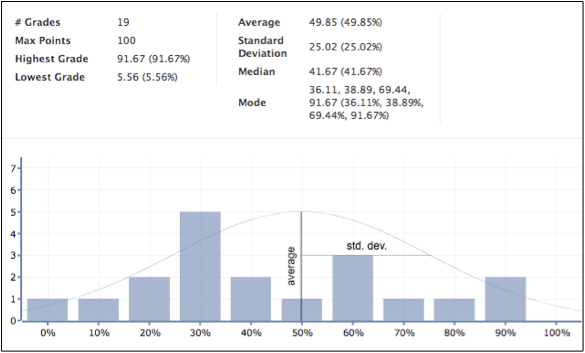
Diagnostic evaluation of “Telling the time” Unit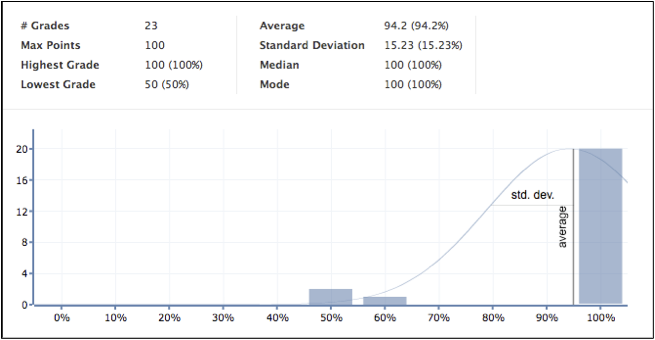
Evaluation of the same unit after the content was taught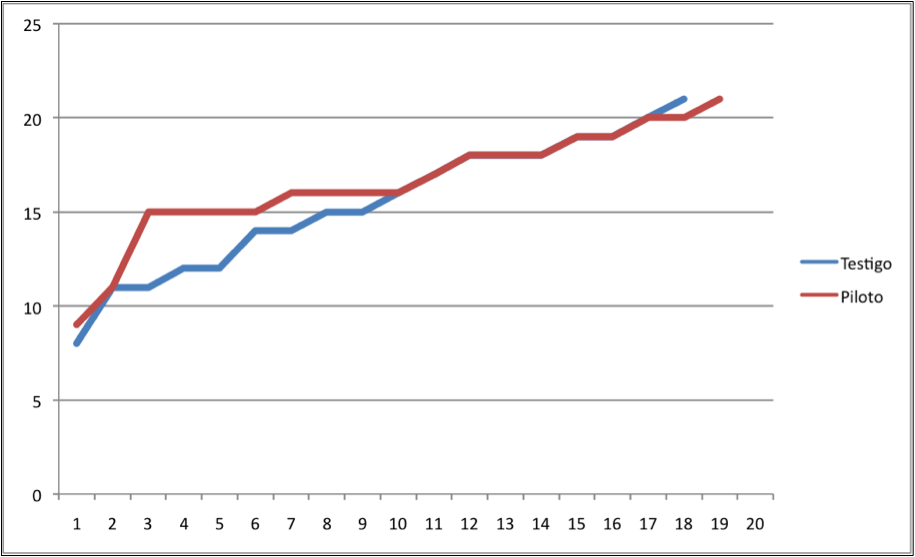
Comparative chart of the final results with the control group being tested in paper and the pilot group being tested in Schoology.
The pilot program for the Spanish curriculum was done with two different themes and subjects
- Science – Plants
- Math – Fractions
We used different methods of blended learning.
For Science: Station rotation: We created 2 stations within the computer lab:An experiment station.A station computer activity station (using Excel). An online interactive activity using Schoology.
We also use lab rotations – One day in the lab using interactive online activities to reinforce the second teacher lead station in the classroom. Both stations with both groups (no differentiation)
For Math: We used stations in the classroom. We also introduce Singapore math concepts to the blended experience.
Station utilizing “manipulatives” to represent fractions:
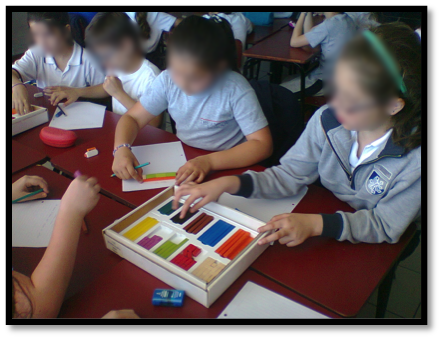
Station representing fractions in paper:

Station with an online interactive activities.
--
The results compared with the control group were done in paper: 

Pros
- Students were more engaged and happy on every activity.
- Differentiation helped struggling students not to be left behind and above average students to grow.
- The subjects were learned more in depth and the retention of knowledge was higher.
- Both teachers in grade 3 were very engage in the pilot and created awesome lessons for the students.
Challenges
- Improve the infrastructure and support of the computers-hardware. Need more time for planning.
Secondary
The secondary pilot project was conducted with different groups in the Spanish and English program:
- Spanish: First year HS Math (same as Eng)
- Fourth year HS Literature
- English: First Year HS Literature (same as Sp)
- Second Year History
- First Year Math
Blended learning was implemented in a whole class lab rotation method. They alternate between a 1 hour lab–1 hour teacher lead period. The students use Schoology for online immediate feedback practice, assessments and interactive content to learn the given units.
Following the philosophy of the blended learning method (the blend of many different pedagogies into one great lesson), we also implemented a method in one of the lab stations created by Dan Meyer ( This is part of his philosophy: Today's math curriculum is teaching students to expect — and excel at — paint-by-numbers class work, robbing kids of a skill more important than solving problems: formulating them. Dan Meyer.)
The teacher created an “abstract video” and students needed to formulate the problem and solve it.
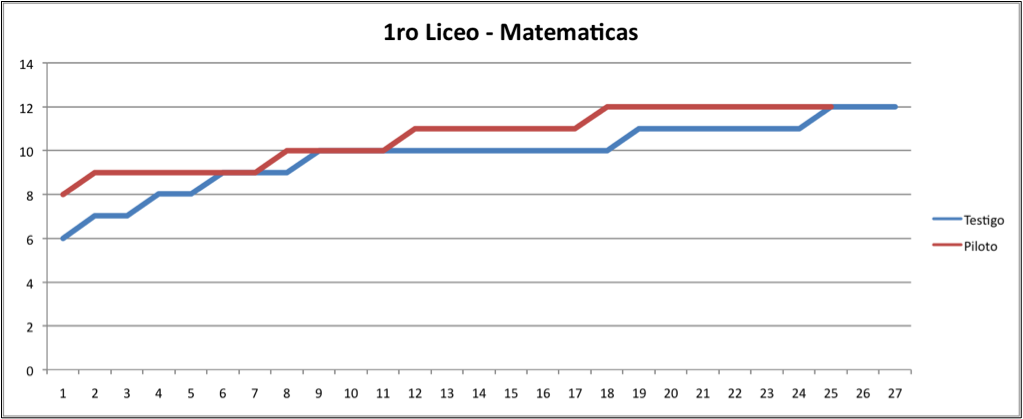
Evaluación – prueba final
Pros
- At the end of the semester, students were more engaged in the material and were able to start thinking “outside the box”, formulating problems.
- The immediate feedback of the online practice helped to reinforce and acquired important concepts.
- More students obtained high marks than the control group.
Challenges
- Students need to change from a passive style of learning to more active learning. These changes caused initial discomfort in the students when required to create, answer, do exercises, discussions, etc. rather than sit and listen to the teacher.
- The infrastructure of the hardware needs to be optimized so that the time spend on fixing audio, connectivity, etc. is minimum.
4th year Literature - Spanish
The results of the pilot program with the Literature class were especially interesting. The students worked on a lab-rotation format one or two hours per week in the computer lab with Schoology creating projects to demonstrate understanding or with interactive activities and quizzes.
Then they had one or two hours with a teacher-led class.Students were apprehensive towards blended learning. The activities were designed for students to be more independent, and they felt uneasy with projects and quizzes. They thought that they needed “notes by the teacher” and felt that it was too much work.
As a result of these concerns, we modified the structure where the material was more spoon-fed (still maintaining projects, quizzes and discussions) to them and the attitudes soon changed. This was a clear indication of a body of students whose previous education had been in exclusively traditional teacher-driven settings.
These particular high-school students were very pre-conditioned to a passive, more dependent method of learning. In the future, teachers will need to explain why the traditional method do not work effectively and why they need to accept control of their own learning. Despite initial relucatnace, it was very interesting that their grade results were considerably higher than the control group.

Form 2 History – English Program
The format in history was a lab-rotation method where students rotated between the lab and the classroom. Students were involved in various research projects to demonstrate understanding of the units and were involved in various online interactive activities. They had class discussions and subject discussions using Schoology.
Some of the concerns were similar to the other high school classes. There was too much work to create the projects and many felt uneasy about the lack of notebook notes. Students were not used to creating their own notes based on their computer activities and video,s and they were not accustomed to demonstrating their understanding of the content through the creation of projects. We modified the methodology so that they felt more "hand-held." By the end of the semester, concern had diminished, especially since their test results were significantly higher.
.
This is one of the quizzes taken for checking understanding
Form 1 – English Literature
In Form 1 we had instances of successful station rotation within the classroom, and the teacher was satisfied with the class flow. There were concerns about class management since the students had never worked with rotations. Therefore, we rotated the computers rather than rotating the students , and this gave better results. The rest of the time we worked on a lab-rotation format, 1-2 hours in the lab and 1-2 hours in a teacher-led class.
The teacher took advantage of the discussion tool within Schoology to ensure that all students had a chance to communicate their ideas and to practice writing in English. Also, many projects and interactive activities were completed to improve reading comprehension and writing.
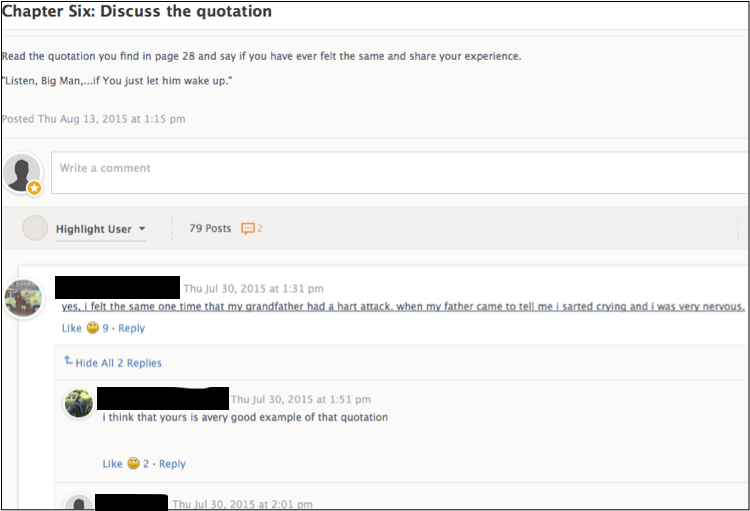
Example of quotes and theme discussions done in Schoology
Outcomes
Positive Outcomes
- Academic Improvement.
- Personalization of learning.
- Student engagement.
- Teamwork and communication between teachers.
Challenges
- Technology – maintenance of lab computers, need for more computers.
- More Resources needed to ensure a robust technology infrastructure.
- Purchase of adaptive software and authoring software.
- The use of diagnostics assessments as a tool
- The need to clarify objectives for each unit taught.
- The need to be able to teach in a non-sequential manner
- Teachers need time to make use of formative and summative assessments in a relevant way. They need to use assessments to create personalized paths for students.
- Teachers need to feel free to dedicate the appropriate amount of time in each unit.
- Some teachers felt pressure to complete units within a set time period rather than allow all students to learn it.
- More PD for teachers – including class management, data analytics, etc.
- Educate students and parents on what is blended learning.
Conclusions
The pilot program opened the eyes of the students and teachers. The teachers were happy with the ideas and the results obtained. It also made them aware that this method requires them to change their way of thinking and reevaluation of previously unquestioned ideas and methods. Therefore, it takes a considerable amount of time and effort to implement properly. The delivery of the day-to-day activities changed, as did the concerns and challenges that arose.
Newer methods require professional teachers who are capable of thinking and implementing ideas outside of their comfort zone, testing things that may or may not work, and incorporating positive elements of each experience to create new ones. Not surprisingly, this is why master teachers tend to excel in this type of environment.
As stated before, blended learning is less about implementing a static model than it is about using a model as a starting point for ongoing iteration and improvement.
Teachers worked hard and created amazing classes that students were very excited about. This energy was reflected in higher retention rates and ultimately improved grades.
It was interesting to see how high school students who had been taught only via traditional teacher-centric methods initially had a difficult time adapting to student-centric hands-on classes. However, the end results were significant improvements in test scores and learning outcomes compared to the control group. This bodes well for the future of similar programs as future age group will be more familiar with the programs and may produce even more significant improvements due to a shorter and less steep adaptation curve. It seems that the passive learning style takes hold in upper elementary school because the lower forms 2 and 3 students in elementary did not express those concerns.
Overall, I think the pilot program worked well, and it demonstrated what it takes to build a blended learning environment. Also, after initial concerns, a large majority of the students responded well to methods introduced.I think that technology is spawning new innovations daily, including adaptive instructional software and assessments, mobile smart phone applications, and digital content. The success of next generation learning models can be enabled by technology, especially through powerful online and blended learning, sophisticated management information systems, and the much-needed data analytics that support student’s learning trajectories.
With access to timely information on student progress, teachers can and will improve their effectiveness when responding to the dynamic educational needs of all children